
The red underwing is a moth of the family Erebidae. The species was first described by Carl Linnaeus in his 1767 12th edition of Systema Naturae.
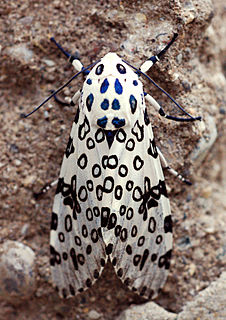
The giant leopard moth is a moth of the family Erebidae. They are distributed through North America from southern Ontario, and southern and eastern United States through New England, Mexico and south to Colombia. The obsolete name Ecpantheria scribonia is still occasionally encountered.

The beet armyworm or small mottled willow moth is one of the best-known agricultural pest insects. It is also known as the asparagus fern caterpillar. It is native to Asia, but has been introduced worldwide and is now found almost anywhere its many host crops are grown. The voracious larvae are the main culprits. In the British Isles, where it is an introduced species and not known to breed, the adult moth is known as the small mottled willow moth.
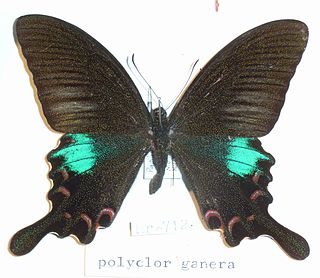
Papilio polyctor, the common peacock, is a swallowtail butterfly found in the Indian subcontinent. It is found in the Himalayas and parts of India from the foothills to 7,000 feet (2,100 m) between March and October. It has distinct dry- and wet-season forms. The butterfly frequents Buddleia flowers. Its food plant is Zanthoxylum alatum of the family Rutaceae. Papilio polyctor has three subspecies, consisting of Papilio polyctor significans, Papilio polyctor stockleyi, and Papilio polyctor xiei.

Lampides boeticus, the pea blue, or long-tailed blue, is a small butterfly that belongs to the lycaenids or gossamer-winged family.
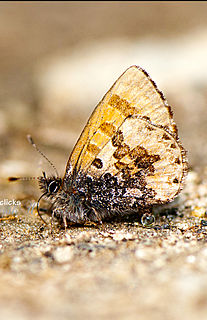
Orthomiella pontis, the straightwing blue, is a small butterfly found in India that belongs to the lycaenids or blues family.

Deudorix epijarbas, the cornelian or hairy line blue, is a species of lycaenid or blue butterfly found in south and southeast Asia from India to Fiji, including the Philippines, and also the tropical coast of Queensland in Australia. The species was first described by Frederic Moore in 1857.

Diloba caeruleocephala, the figure of eight, is a moth of the family Noctuidae. It is found in the Palearctic.
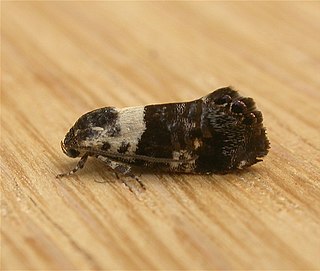
Eupselia aristonica is a species of moth of the family Depressariidae. It is found in Australia, where it has been recorded from New South Wales, the Australian Capital Territory, Victoria and Tasmania.

Cosmorhoe is a monotypic moth genus in the family Geometridae erected by Jacob Hübner in 1825. Its only species, Cosmorhoe ocellata, the purple bar, was described by Carl Linnaeus in his 1758 10th edition of Systema Naturae.

Mesapamea secalis, the common rustic, is a moth of the family Noctuidae. The species was first described by Carl Linnaeus in his 1758 10th edition of Systema Naturae. It is found in Europe, north-west Africa, Turkey and northern Iran.
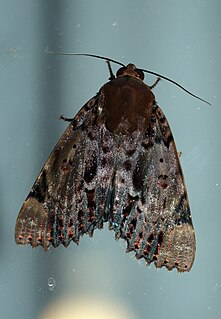
Arcte coerula, the ramie moth, is a moth of the family Noctuidae. The species was first described by Achille Guenée in 1852. It is found from in south-east Asia, including Fiji, India, Sri Lanka, Myanmar, Japan, New Guinea, Taiwan and Norfolk Island. It has been recently observed in Hawaii, on the island of Maui.

Zygaena purpuralis, the transparent burnet, is a moth of the family Zygaenidae.

Trabala vishnou, the rose-myrtle lappet moth, is a moth of the family Lasiocampidae. It is found in southern Asia, including Pakistan, India, Thailand, Sri Lanka, Myanmar, Java, China, Japan, Taiwan, Hong Kong, Vietnam and Indonesia. Four subspecies are recognized.

Varieties of the color blue may differ in hue, chroma, or lightness, or in two or three of these qualities. Variations in value are also called tints and shades, a tint being a blue or other hue mixed with white, a shade being mixed with black. A large selection of these colors is shown below.

Structural coloration in animals, and a few plants, is the production of colour by microscopically structured surfaces fine enough to interfere with visible light, sometimes in combination with pigments. For example, peacock tail feathers are pigmented brown, but their microscopic structure makes them also reflect blue, turquoise, and green light, and they are often iridescent.

Scelophysa trimeni, commonly known as the blue monkey beetle, is a species of scarab beetles in the monkey beetle subfamily Rutelinae.
Nealyda kinzelella is a moth of the family Gelechiidae. It was described by August Busck in 1900. It is found in North America, where it has been recorded from Florida.
Nealyda pisoniae is a moth of the family Gelechiidae. It was described by August Busck in 1900. It is found in Cuba and the United States, where it has been recorded from Florida.

Trachypepla minuta is a moth of the family Oecophoridae first described by Alfred Philpott in 1931. It is endemic to New Zealand and has been collected in Auckland. Adults of this species are on the wing in December. It is distinguishable from similar species as it is smaller in size and darker in appearance than other species in the genus Trachypepla.
















